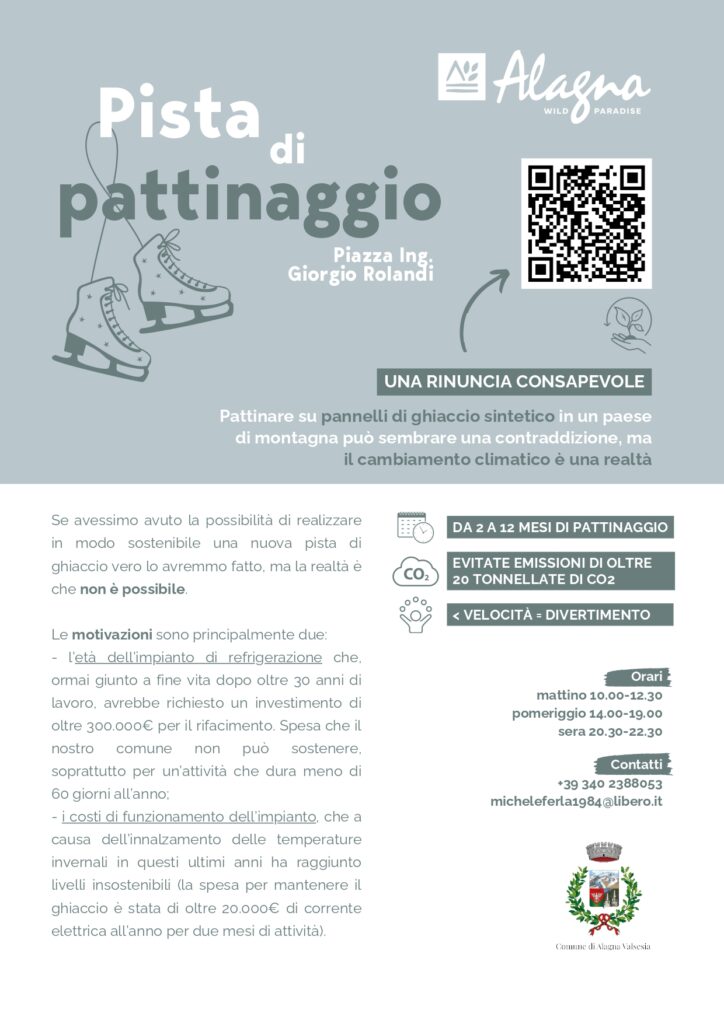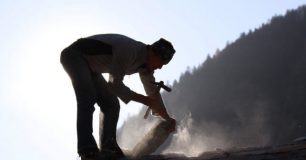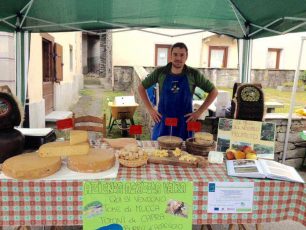Home / Experiences / Ice-Skating Ring in Alagna
A CONSCIOUS RENUNCIATION
Skating on synthetic ice panels in a mountain village may seem like a contradiction, but climate change is a reality and we cannot pretend it does not exist.
'They make real ice rinks in the city and they can't make them in the mountains', we know this is the first thought of many. However, the decision to lay a synthetic ice rink was our only sustainable choice.
If we had the chance to make a new real ice rink in a sustainable way we would have done it, but the reality is that it is not possible.
There are many reasons for this, but mainly two:
the age of the refrigeration system, which, now at the end of its life after more than 30 years of work, would have required an investment of more than €300,000 to refurbish. An expense that our municipality cannot afford, especially for an activity that lasts less than 60 days a year;
the operating costs of the facility, which due to the rise in winter temperatures in recent years has reached unsustainable levels (the cost of maintaining the ice was over €20,000 in electricity per year for two months of activity).
At one time, the ice rink was made in a meadow, spitting water and letting nature do the rest. In the 1990s, with the construction of the facility at the Palazzetto, Alagna was equipped with a modern, high-performance ice skating rink, the temperatures allowed the ice to be maintained with the aid of little energy, and the rink was usable throughout the winter season. At that time, everything 'worked': the cold weather began in November, the ski slopes were naturally snow-covered all the way to the village, and the ice skating rink was a great success.
In the first decade of the 2000s, something started to crack, the construction of snowmaking systems on the lower altitude slopes began, and the ice rink compressors started having to work at full capacity to maintain the ice. In the last decade, we have built snowmaking facilities above 3,000 metres, and in the village in the last three years, snow has hardly been seen. It rains in the middle of winter and doesn't freeze for weeks. Needless to say, the system built 30 years ago is not only at the end of its life but also no longer suitable for the current climate.
Last year, we had to take the decision to put our hands on the track. Having contacted a number of companies and requested cost estimates, which exceeded €300,000 for a traditional facility, our administration found itself at a crossroads: build a new rink, much smaller than the current one and therefore unable to accommodate the many people who choose Alagna in winter, or try to leave the past behind and find a different solution, synthetic ice.
The panels you now find in place of ice do not provide an experience comparable to real ice. We know that. But we also know that ski purists didn't like programmed snow when it started to replace natural snow. Today, without programmed snow, one could no longer ski. Today without artificial ice in Alagna we would no longer have a skating rink.
When you enter the rink, we ask you not to compare the plastic panels with real ice because we know very well that "on ice is a different matter"; instead, we ask you to think that you are having a different experience, that you will be able to have fun together even without "sliding like on real ice" and that you will be able to learn to skate just like on real ice.
When you are sliding on artificial ice, think about the fact that you are having fun without burdening the environment, as this choice allows us to save more than 60,000 KWh of electricity (for 2.5 months of activity), equal to more than 20 tonnes of CO2 equivalent, not to use refrigerant gases that are extremely harmful to the climate and, above all, to skate all year round.
The choice of synthetic ice does indeed have this privilege: it allows skating not only in winter but also in the height of summer, thus increasing annual activity from 2 to 12 months.
Why the synthetic ice rink?
Because it was the only alternative to closing the facility forever. The new climatic context and the size of the rink would have imposed unsustainable construction costs on the municipality of Alagna.
Temporary rinks in the city can only be built at a very high cost and only on a small scale.
Synthetic ice will allow skating even in the middle of summer, without energy costs and with maximum environmental protection.
Is skating on synthetic ice like skating on real ice?
Yes and no. The skating technique is identical, and especially for beginners, synthetic ice allows them to learn good classic skating technique. The difference lies in fluidity. Synthetic ice requires more pushing and does not 'glide' like natural ice.
Is it fun to skate on synthetic ice?
A beginner might not find any difference between synthetic ice and real ice, indeed perhaps synthetic ice makes it easier to learn ice skating. For those who skate for fun without expecting to slide at high speed, synthetic ice offers an experience as enjoyable as skating on real ice.
For more experienced skaters looking for speed, jumps and acrobatics, synthetic ice has some limitations compared to natural ice.
Synthetic ice certainly provides the most fun for children who want to play on the ice with skates.






